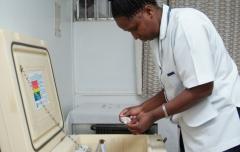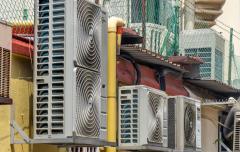Can we unlock financing for access to sustainable cooling?
Financing access to sustainable cooling is complicated. Needs for cooling vary dramatically across businesses and populations, and cooling solutions tailored to different groups each call for their own unique financing mechanisms.
There are also significant financing barriers to overcome. Some barriers can be overcome with modest risk mitigants to attract private capital. Others will require substantial subsidies. And others can only be addressed with grants. Similarly, potential sources of funding will vary according to the likelihood of commercial returns, the local investment climate, the scale of investment and other factors.
A new knowledge brief from Sustainable Energy for All (SEforALL), in support of the Kigali Cooling Efficiency Program (K-CEP), details current challenges for access to sustainable cooling finance, but also opportunities and recommendations for overcoming them.
Here is an overview of the knowledge briefs' findings.
Access to cooling finance challenges
Challenge 1: The diversity and complexity of cooling needs across human comfort and safety; food, nutrition security and agriculture; and health services are part of the challenge in identifying financing solutions. Finding ways to make more efficient and climate-friendly systems with low upfront costs widely available is a major challenge that will require consumer financing and incentives, among others. Agricultural cold chains and food systems likely necessitate grants or highly concessional finance to stimulate market development, and health services will likely require highly concessional finance.
Challenge 2: The diversity and complexity of funding: as there is a wide range of financial tools that will be needed because not every type of finance or funding mechanism will be relevant or suitable for all cooling solutions. The diverse challenges will require targeted financial instruments, that must be carefully matched with financing parties and beneficiaries.
Challenge 3: The diversity and complexity of the financial sector, which is locally specific where risk-averse private sources dominate, while public and philanthropic sources with greater risk tolerance are much more limited. The financing challenge is to attract capital to emerging markets where the need is highest.
Challenge 4: The ability to track data and evidence, as a formal tracking effort to understand access to cooling finance remains a key need for the community in order to establish a comprehensive baseline for investment, understand the trends and gaps, and to redirect efforts where further effort is required. Tracking also helps enable target setting and benchmarking that can allow implementation organizations to realize new opportunities.
Opportunities in finance for access to cooling
Opportunity 1: Consideration of access to cooling by climate funds, which has been very limited except for a few initiatives promoting more efficient appliances and more efficient buildings. There are some indications that awareness of the importance of cooling issues within these funds may be increasing, particularly within the Montreal Protocol, Green Climate Fund, and the Global Environmental Facility.
Opportunity 2: Coordination of funding for refrigerant replacement and for improving energy efficiency by reducing the operational and procedural complexities. New opportunities may arise from the Climate Investment Platform, which seeks to streamline general climate finance.
Opportunity 3: Recognition that blended finance can increase the impact of public funds by leveraging public and philanthropic support. To deliver access to cooling, blended finance requires business models that can produce cash flows over time.
Opportunity 4: Technical assistance to improve the environment for investment is necessary to unlock capital, as well as for considering the co-benefits related to the Sustainable Development Goals.
Opportunity 5: Development of national cooling action plans are key opportunities for preparatory activities related to financing access to cooling solutions. The diverse range of public agencies relevant to cooling needs means that governments will need to coordinate across ministries and stakeholders in order to apply for centralized financing.
Opportunity 6: Linking access to cooling to the Nationally Determined Contributions (NDCs) and National Adaptation Plans (NAPs), two processes that can be used to facilitate finance for access to sustainable cooling given their broad scope and ability to attract technical assistance financing.
Opportunity 7: Bulk procurement of sustainable cooling solutions can address issues of scale with respect to the cost and efficiency of finance. Small, dispersed transactions are typically more costly to process, and the challenge becomes still greater if purchasers are low income and lack creditworthiness.
Recommendations for further action
There have recently been promising developments on access to cooling financing, including the World Bank’s technical assistance program to accelerate sustainable cooling solutions and the GCF’s inclusion of cooling in its strategic prioritization, among other initiatives. We must find a way to build on these early successes while addressing areas that have not received enough attention to date.
Recommendation 1: Track, report and share experiences
Development and climate finance are still in nascent stages of addressing access to cooling. Because of this, there is an urgent need for tracking, reporting, and the sharing of experiences – ideally in a partnership that brings relevant parties together to define access to cooling finance, including its relationship to energy access.
Recommendation 2: Link national cooling action plans to the Sustainable Development Goals (SDGs) and Nationally Determined Contributions (NDCs)
The focus on air conditioning, and to a lesser extent refrigeration, in response to the Kigali Amendment is promising, but there is still a long way to go. Countries with vulnerable groups without access to cooling should be developing national cooling action plans that link to the SDGs and support the NDCs to identify opportunities for finance. For countries that have developed a national cooling action plan, there may be a need to use a subsequent strengthening or implementation phase to realize better linkages to the SDGs.
Recommendation 3: Continuing success of the Kigali Cooling Efficiency Program (K-CEP)
The philanthropic K-CEP has delivered catalytic finance across its delivery windows with relatively limited resources. With many initiatives still in nascent stages and a need to show how technical and financial innovation can be delivered at scale, it is important that the K-CEP be continued through 2025 and, if possible, expanded through the addition of bilateral and multilateral donor funding.
Recommendation 4: Build evidence of the benefits of agriculture cold chain
The issue of cold chains for rural agriculture has not received nearly the attention it should given the strong linkages to the SDGs and economic benefits. A lack of data on cold chain breakdowns remains a barrier to market development, and modest finance for technical assistance could make a valuable contribution.
Recommendation 5: Build evidence of the benefits of health services cold chain
Health issues have a small dedicated constituency that could be linked more effectively to the larger challenge of delivering access to cooling. The sector could channel finance through its procurement power and incentives to ensure innovative, energy-efficient cooling technologies such as solar direct-drive vaccine refrigerators are available and affordable for health facilities in low-income countries.
Recommendation 6: Coordinate refrigerant phasedown and efficiency improvement funding
Financing for the refrigerant HFC phasedown and energy efficiency improvements will be more effective when coordinated. Development agencies and financing institutions must advance financial solutions and facilities that bridge the divide. Timing is critical. Without quick action, we may not be able to fully realize the climate benefits of the HFC phasedown and deliver access to cooling.
Read the full SEforALL Knowledge Brief.




